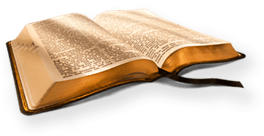King James Bible
King James Version (KJV)


"The evangelist; "John whose surname was Mark" (Acts 12:12, 25)." "Mark (Marcus, Col. 4:10, etc.) was his Roman name, which" gradually came to supersede his Jewish name John. He is called "John in Acts 13:5, 13, and Mark in 15:39, 2 Tim. 4:11, etc." "He was the son of Mary, a woman apparently of some means and "influence, and was probably born in Jerusalem, where his mother" resided (Acts 12:12). Of his father we know nothing. He was cousin of Barnabas (Col. 4:10). It was in his mother's house "that Peter found "many gathered together praying" when he was" released from prison; and it is probable that it was here that "he was converted by Peter, who calls him his "son" (1 Pet." "5:13). It is probable that the "young man" spoken of in Mark" "14:51, 52 was Mark himself. He is first mentioned in Acts 12:25." He went with Paul and Barnabas on their first journey (about "A.D. 47) as their "minister," but from some cause turned back" when they reached Perga in Pamphylia (Acts 12:25; 13:13). Three "years afterwards a "sharp contention" arose between Paul and" "Barnabas (15:36-40), because Paul would not take Mark with him." "He, however, was evidently at length reconciled to the apostle," for he was with him in his first imprisonment at Rome (Col. 4:10; Philemon 1:24). At a later period he was with Peter in "Babylon (1 Pet. 5:13), then, and for some centuries afterwards," one of the chief seats of Jewish learning; and he was with Timothy in Ephesus when Paul wrote him during his second imprisonment (2 Tim. 4:11). He then disappears from view. It is the current and apparently well-founded tradition that Mark derived his information mainly from the discourses of Peter. In his mother's house he would have abundant opportunities of obtaining information from the other apostles "and their coadjutors, yet he was "the disciple and interpreter" "of Peter" specially." "As to the time when it was written, the Gospel furnishes us with no definite information. Mark makes no mention of the "destruction of Jerusalem, hence it must have been written before" "that event, and probably about A.D. 63." "The place where it was written was probably Rome. Some have supposed Antioch (comp. Mark 15:21 with Acts 11:20). "It was intended primarily for Romans. This appears probable when "it is considered that it makes no reference to the Jewish law," and that the writer takes care to interpret words which a "Gentile would be likely to misunderstand, such as, "Boanerges" "(3:17); "Talitha cumi" (5:41); "Corban" (7:11); "Bartimaeus" "(10:46); "Abba" (14:36); "Eloi," etc. (15:34). Jewish usages are" also explained (7:3; 14:3; 14:12; 15:42). Mark also uses certain "Latin words not found in any of the other Gospels, as" "speculator (6:27, rendered, A.V., "executioner;" R.V.," "soldier of his guard), "xestes" (a corruption of sextarius," "rendered "pots," 7:4, 8), "quadrans" (12:42, rendered "a" "farthing"), "centurion" (15:39, 44, 45). He only twice quotes" from the Old Testament (1:2; 15:28). "The characteristics of this Gospel are, (1) the absence of the "genealogy of our Lord, (2) whom he represents as clothed with" "power, the "lion of the tribe of Judah." (3.) Mark also records" "with wonderful minuteness the very words (3:17; 5:41; 7:11, 34;" "14:36) as well as the position (9:35) and gestures (3:5, 34;" 5:32; 9:36; 10:16) of our Lord. (4.) He is also careful to "record particulars of person (1:29, 36; 3:6, 22, etc.), number" "(5:13; 6:7, etc.), place (2:13; 4:1; 7:31, etc.), and time" "(1:35; 2:1; 4:35, etc.), which the other evangelists omit. (5.)" "The phrase "and straightway" occurs nearly forty times in this" "Gospel; while in Luke's Gospel, which is much longer, it is used" "only seven times, and in John only four times." "The Gospel of Mark, says Westcott, "is essentially a transcript from life. The course and issue of facts are imaged "in it with the clearest outline." "In Mark we have no attempt to" draw up a continuous narrative. His Gospel is a rapid succession of vivid pictures loosely strung together without much attempt to bind them into a whole or give the events in their natural sequence. This pictorial power is that which specially "characterizes this evangelist, so that `if any one desires to" "know an evangelical fact, not only in its main features and" "grand results, but also in its most minute and so to speak more" "graphic delineation, he must betake himself to Mark.'" The" leading principle running through this Gospel may be expressed "in the motto: "Jesus came...preaching the gospel of the kingdom" (Mark 1:14). "Out of a total of 662 verses, Mark has 406 in common with "Matthew and Luke, 145 with Matthew, 60 with Luke, and at most 51" "peculiar to itself." (See [379]MATTHEW.)" "Any place of public resort, and hence a public place or broad" "street (Matt. 11:16; 20:3), as well as a forum or market-place" "proper, where goods were exposed for sale, and where public" assemblies and trials were held (Acts 16:19; 17:17). This word occurs in the Old Testament only in Ezek. 27:13. "In early times markets were held at the gates of cities, where commodities were exposed for sale (2 Kings 7:18). In large towns the sale of particular articles seems to have been confined to "certain streets, as we may infer from such expressions as "the" "bakers' street" (Jer. 37:21), and from the circumstance that in" the time of Josephus the valley between Mounts Zion and Moriah "was called the Tyropoeon or the "valley of the cheesemakers."
Definition of Mark:
"same as Marcus"
Related Bible Dictionary Terms:
Mark Gospel according to